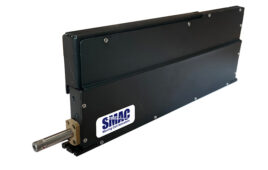|
Listen to this article
|

The unique bi-stable design of the actuator allows it to snap back and forth quickly with temperature changes. | Source: North Carolina State University
A research team at North Carolina State University (NCSU) has developed a quicker thermal actuator for soft robotic devices. Actuators create motion by converting energy into work.
“Using thermal actuation is not new for soft robots, but the biggest challenge for soft thermal actuators was that they were relatively slow – and we’ve made them fast,” Yong Zhu, corresponding author of the paper and the Andrew A. Adams Distinguished Professor of mechanical and aerospace engineering at NCSU, said.
The key to the team’s actuator’s quick movements is in its bi-stable design, and the shape it prefers depends on the temperature.
The research team put silver nanowires between two layers of different materials on top of each other. The two materials will heat and expand at different temperatures, as that happens the structure will bend.
At a certain point, once the structure reaches a critical temperature, it will snap into place. Once it snaps into place the structure is stable again. The same process occurs as the structure cools. The critical temperatures, however, will be different, with the heating critical temperature being higher.
“Think of a snap hair clip. It’s stable until you apply a certain amount of energy (by bending it over), and then it snaps into a different shape – which is also stable,” Shuang Wu, first author of the paper and Ph.D. student at NCSU, said.
The researchers created two prototypes to test their method. The first snaps shut or open, mimicking the movement of a venus flytrap. The second’s snapping movement helps it to crawl, moving at more than one body length per second.
The actuator has potential applications in a variety of industries, from biomedical applications to manufacturing.
Moving forward, the team hopes to automate the process by creating sensor and control mechanisms.
“We’re also interested in exploring other possible materials, so that we could fine-tune the thermal and mechanical properties,” Zhu said. “This could allow us to tailor both actuator speed and force.”
Editor’s Note: You can read the team’s entire research here.






Tell Us What You Think!